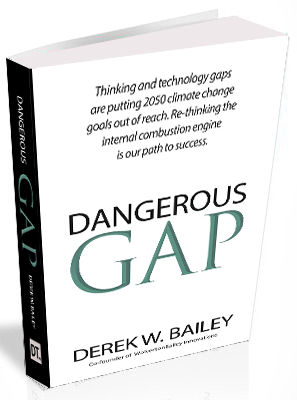
There’s been a lot of talks lately about engine efficiency, especially through the recent rise of electric vehicles in The United States and other clean engine technology.
One of them, is what is known as Counterpoise Bi-Radial Engine, a state of the art internal combustion engine that has a mechanical advantage over other engines of its kind. Its main design feature is a unique angle of travel that allows pistons to stay in constant motion, utilizing more of the power stroke for work.
Recently, I had a chance to chat with Derek Bailey, one of the co-founders of WolvertonBailey, a research and development lab aimed at creating this brand new type of Counterpoise Bi-Radial Engine.

WolvertonBailey Natural Gas Engines recently teamed up with FEV to produce the new Counterpoise Bi-Radial Engine, tell us more about it…
FEV engineering’s job is to turn our engine cycle design into an actual engine that can be put into a vehicle. First, we’re perfecting the cycle. An engine cycle is a method of operating an engine, and many versions of that engine cycle can be built - an example of what I’m saying would that many different firms have their version of a diesel engine, but they all use compression to ignite the fuel - that how a diesel cycle works. The weakness in all engine cycles to date is that they only capture a fraction of available from the fuel. Imagine a small explosion in a chamber. There would be action and reaction, right? Meaning it explodes in different directions. Well, every other engine cycle only captures one side of the explosion to push the piston down; the opposite pressure is wasted to the cooling system and is expelled as pollutions. Our engine cycle captures the opposite end of the explosion and uses it for more power in the engine, meaning less waste. After perfecting the cycle, the first engine we will build from our new cycle will be a Class-8 heavy engine that is optimized to run on liquefied natural gas. We want to demonstrate right out the gate that our engine cycle will produce engines with near-zero emissions, and very high MPG. FEV provides the engineering depth and expertise we need to do this right.
You indicated that you are in your final stage of funding, before the build out of the vehicle, what should buyers expect?
The market should expect two dramatic product announcements from WolvertonBailey: First, a Semi truck engine that gets 15+ MPG, with near-zero emissions. We are benchmarking this engine against the Cummins-Westport ISLG natural gas engine, which is considered a national standard for efficiency and emissions. Our engine will be nearly half the size, with the same power and torque, have an even better carbon footprint, and will crush the ISLG’s 9+ MPG. Next comes the real smack-down. While other trucks drive around looking for natural gas fueling stations that don’t yet exist, our vehicles will have an onboard micro-natural gas conversion system, which allows the vehicle to liquify its own natural gas for any regular old gas line. This will save billions in construction cost to build liquified natural gas fueling stations. Liquifying the gas allows the vehicle to carry more fuel, for extended range. This technology will spill over into the car and light-truck markets creating a little disruption in the EV market as well.
You make very strong claims and comparisons with your new engine developments, how does your developments rank against Tesla’s new Semi or any other manufacturer?
You’re a smart consumer - Let me ask you a buying question. Your boss gives you a truck budget. You can pay a 35% premium for a cool truck that’s all-electric, offers a little less storage, and is a little heavier, because of all the batteries, and doesn’t have charging stations along all routes, limiting your use of the truck (except for PR), except its all over the media that your new electric Semi is not ‘green’ i.e. some reporter points out that they are burning coal in Chicago to recharge your cool truck. Or, you can buy the, cheaper, new, WolvertonBailey Semi, with its efficient Counterpoise Bi-Radial Hybrid-electric natural gas engine that has an, onboard, micro-scale natural gas conversion unit, (about the size of a mini-wine-fridge) allowing the truck to liquify its own natural gas from any natural gas line, giving the truck 7-times the driving range, and you can document your carbon footprint from each truck - which is near-zero emission. Which would you buy? Clearly, we are going to gut punch this market.
Tesla is said to be the future of the industry, do you agree? In your expert opinion how would you educate the unknowing consumer or potential investor about the future of the industry based on current realities, and the political landscape?
Look, no one makes a better electric vehicle than Tesla. We are in a battle against climate change, and consumers are attracted to EV’s, in part, because they are seen as climate change fighters. But this mostly - NOT TRUE. Electric vehicles are, in most cases, “pollution shifters” - i.e. no emission from the vehicle because the emission occurs at the power source, which about 86% of the time is NOT a ‘green’ or ‘renewable’ energy source. This will change someday, but not soon. Consumers are becoming aware, and investors should be aware, that electric cars have a carbon footprint, and even worse that carbon footprint varies from place to place and even by time of day. With the introduction of WolvertonBailey’s clean hybrid-electric engine, consumers and investors can expect to see a new generation of, near-zero-emission, high MPG, hybrid-electric vehicles that have a carbon footprint about equal to an electric vehicle. This will drive real competition. In the heavy-engine sector, we don’t think EV’s have a change against our technology. In my opinion, EV sales will continue to grow, and Tesla will lead that sector, but pure EV’s will not be the runaway product that some predict.
Consumers are finally getting excited about the booming electric car industry; you have a new book coming out, what are your thoughts on this growing market segment?
I think consumers should be excited about the electric car industry, great technology is coming out of the sector. Unfortunately, my book does point to the fact that in 2016, 86% of the electricity recharging electric cars comes from burning fossil fuels; so packing the electric grid with electric cars is not a solution to climate change. People can love and should buy these cool new cars, but my book makes it clear that electric vehicles, currently, aggravate, not solve, the climate problem. Electric cars can only be ‘green’ if their recharge comes from a green energy source - which 86% of the time is NOT the case, right now. Of course this will change, as the electric grid gets greener and smarter. Our technology incorporates clean natural gas into a highly efficient IC engine and with a new emission filter to produce a vehicle with a carbon footprint comparable to the real carbon footprint of the EV. Most people have natural gas at their home so the battle will become clean natural gas vs. electric. The market is about to become very interesting, to say the least.
In a recent statement you made to the press, you said Tesla’s new Semi does absolutely nothing to change the fact that electric vehicles cannot be a ‘truly' green technology until they are recharged by a green electric-grid, which is at least 100-years in the future; Can you elaborate…?
First, let me say ‘I love the electric powertrain - it has many advantages.’ But again, only ‘green’ electric grid can make the electric vehicle ‘green.’ If the grid generates electricity from green / renewable sources (sun, wind, etc.) then the electric vehicle can be considered ‘green.’ But right now, that Tesla Semi will be recharged from electricity generated by burning coal in Chicago and Detroit, by natural gas in someplace else, or some other fossil fuel in another place. Our own EPA acknowledges that our electric grid will rely heavily on fossil fuels into the foreseeable future. According to the U.S. Energy Information Administration renewables makeup only 6% of power generation. It will take years to build the transmission lines, last-mile infrastructure, and renewable sources to make electric vehicles ‘green.’ Tesla’s Semi will add a considerable burden to the electric-grid in many places. This is a great technology before its time.
Your new book is entitled a “Dangerous Gap: Will Humanity Survive The 100-Year Gap To A Green Electric Grid?” What was the motivation behind the book?
My best friend recently purchased a new car, and her nephew told her she should have purchased an electric vehicle to help fight climate change, this is in Pennsylvania. I visited by daughter in Chicago and I hear similar comments. I’m thinking ‘are you kidding me?” I decided I needed to write a book for the laymen that lays out the climate change dilemma in easy to understand language, with a focus on understanding how and when we get to a green electric-grid. To explain that the more we know about what’s actually happening with climate change, the causes, and most importantly that the efforts of many will be needed to solve the climate problem.
When should we expect the book to be released and what do you want your readers to take away?
My book will be released in February 2018. I’m hoping to contribute to the average persons understanding of the climate change challenge and of the technologies we are deploying to combat it, as well as a better understanding of how dependent we are on fossil fuels. Of course, I pitch our new WolvertonBailey engine cycle as a part of the solution. We will wean our world off of fossil fuels, in time. But between now and 2050, WolvertonBailey wants to ensure that even while fossil fuels go into an engine, little to no pollution will come out of the engine. It may sound strange, but our new combustion engine will allow us to survive till we can build a global ‘green’ electric grid. The engine that made us will save us.
